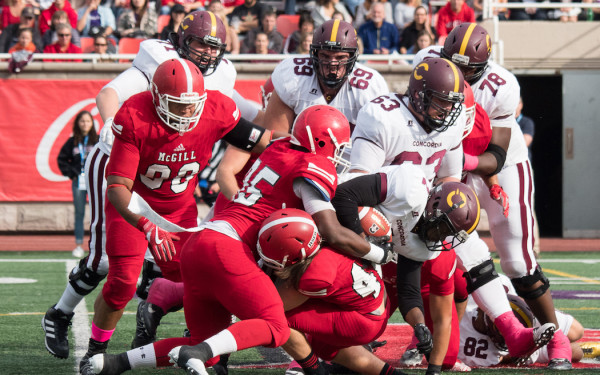Dribbling Out The Snow
As Soccer Players Head Indoors, They Also Head into a Different Game
The winter months aren’t friendly to Canada, and the world of Quebec soccer isn’t exempt from such harsh conditions. The only solution to protecting this beautiful game from the freezing wind and snow showers is to bring it indoors.
Unlike futsal, which is played in a gymnasium, the Réseau de sport étudiant du Québec’s indoor soccer is played in indoor sports complexes. Players run on synthetic turf as opposed to wooden floor tiles and the pitch dimensions resemble the ones from the outdoor leagues.
Besides moving from under the sun to under a roof, are there differences between playing in the outdoor league in the mild autumn months and the indoor league during the cold winter months?
“It depends on the fields, but there is a big difference,” explained Philippe Eullaffroy, the Montreal Impact Academy director who coaches a team playing in the RSEQ’s indoor league. “[From] a more scientific standpoint we don’t have the same wind resistance or temperature. We also don’t
have the same pitch size, and we don’t even have the same depth perception.”
The difficulties with depth seem to be shared by Concordia Stingers men’s soccer coach Greg Sutton.
“It is a little harder. The way you pick up the ball is a little different because of the lighting and the whole aspect of the [Stingers] dome.”
“Most of the times, the pitches are smaller plus the notion of depth since the walls are closer means the players don’t have the same perception. We have problems with losing our groundings,” said Eullaffroy. “For some reason, the human brain is made in a way that if someone has walls around them, they feel contained and that effects their depth perception.”
Some even tend to enjoy the indoor game better than playing in the outdoors.
“Honestly, there’s a little difference but I find it better to play indoors. The ball moves easier and the play goes along well,” said Odaine Demar of the Stingers men’s soccer team. “If the team has all their stuff sorted out, it’s fine.”
As the months go by and the snow melts, the soccer teams prepare to go outside and will then need to transition from playing in a dome or a sports complex to a regular outdoor soccer pitch.
“There isn’t a real issue with transitioning from indoor to outdoor but rather going from indoor to outdoor. We need some time to adapt when we go outdoors,” confessed Eullaffroy. “That’s why it’s delicate for teams in Montreal and across the province to train and play indoors and then go outdoors and quickly go into a competitive match. That’s tough on the players.
“When we play inside it’s warm and cozy at around 20⁰ Celsius, but when we go outdoors in April it’s about 2⁰ Celsius and there’s still snow outside. On a physiological level it’s difficult, on a wind resistance level also and we’ve got trouble adapting in the first few days on the energy that training outdoor demands.”
“It’s a completely different ballfield, from playing on the grass to playing indoors,” said Demar. “Adjusting to the space that you have and to know the size of the field so you do have to adapt.”
As for Sutton, he doesn’t need to focus on getting players ready for a summer season and is not concerned about the transition. “I don’t think we really have to adapt, we just move back outside,” he said. “We’re just happy to be back outside.”
Indoor soccer is also less competitive than its outdoor counterpart. The league is used as an experimental period in which to prepare for the more competitive season.
The Montreal Impact Academy has a team that plays a friendly game against each team in the league. This is seen as a good, competitive training for the under 18s.
“It’s seven quality games that we can play between January and March, a difficult time frame to find quality friendly matches,” said Eullaffroy. “It’s great, and everyone, both the universities and us, are happy to be part of this league for what I believe is the fifth year now. It’s a nice tool to use for us when we restart [our] season.”
“For us, we look at the indoor season as more of a season for us to work on a lot of the individual work […] and look at the player that maybe didn’t play so much in the fall,” added Sutton. “We’re not so much concentrated on where we are as much as the progression of our team.”

1_900_354_90.jpg)
2_900_610_90.jpg)
_600_832_s.png)

1_600_375_90_s_c1.jpg)
2_600_375_90_s_c1.jpg)
_600_375_90_s_c1.jpg)
